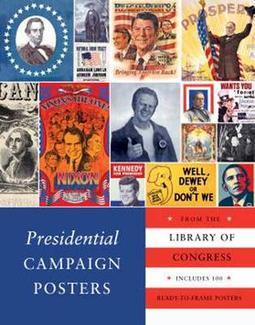
By The Library of Congress
(Quirk Books)
OK, political groupies, travel back through time to the campaigns of yesteryear. You can even wallpaper your bedroom with (long dead) politicians touting their virtues ― and sometimes sliming their opponents.
“Presidential Campaign Posters” ― an oversized book from the Library of Congress ― is exactly what it says ― wall posters ― but with the added dollop of history on the side.
In the preface, Brooke Gladstone of National Public Radio says about campaign art, “Fundamentally, it isn’t pitching politicians; it’s hawking images of America. The America we yearn for. Or, when the message is negative, the America we fear.”
If you thought this year’s endless political bickering was ugly, travel back to 1828 when Andrew Jackson ran against John Quincy Adams. Jackson, a hero of the War of 1812, handed out campaign loot like hickory sticks in honor of his nickname, “Old Hickory.” Adams’ campaign struck back attacking him and his decisions.
Jackson supporters reacted in kind. “Fed up with accusations that Jackson murdered the innocent, newspaper editor Isaac Hill printed the following statement in the New Hampshire Patriot: ‘On the 8th of January, 1815 (Jackson) murdered in the coldest kind of cold blood above fifteen hundred British soldiers for merely trying to get into New Orleans in search of Beauty and Booty!’ What began as a taunt became a campaign slogan what would lead Jackson to the presidency.”
In 1856, you have a woodcut of a donkey with the caption of “The above is a true likeness of ‘ten cent Jimmy’ Buchanan, the ‘Damed-Black-Rat’s’ candidate for President.” James Buchanan won the presidency despite the poster.
Campaign buttons were popular in 1860 when a tintype photograph campaign button with Lincoln and his vice-presidential nominee Hannibal Hamlin was issued.
One of the beauties of this book is that it doesn’t restrict itself to posters of the winners. Included are losers in the presidential battle, and other groups like the Socialist Party in 1904 whose candidate, Eugene V. Debs, lost badly to Theodore Roosevelt. The Party’s animals became a shortcut for voters to know who to look for. In 1912, Woodrow Wilson went against William Howard Taft, Eugene Debs and Theodore Roosevelt. The cover of a campaign song sported a Democratic donkey for Wilson, a Republican elephant for Taft and a Bull Moose for Roosevelt.
Poster makers followed popular trends through the decade. Robert (Bobby) Kennedy had a psychedelic hip look in 1968. Gerald Ford’s poster in 1976 was a takeoff on Fonzie in television’s “Happy Days.”
It concludes with the iconic poster of Barack Obama from the 2008 campaign with the caption, “hope.”
Gladstone has the last word: “As you look at each poster and read about each campaign, it becomes increasingly clear that the tug of war over taxes and trade, the distribution of wealth and power, and the role of government itself, will never end.” (MCT)
-
Articles by Korea Herald








![[Graphic News] More Koreans say they plan long-distance trips this year](http://res.heraldm.com/phpwas/restmb_idxmake.php?idx=644&simg=/content/image/2024/04/17/20240417050828_0.gif&u=)
![[KH Explains] Hyundai's full hybrid edge to pay off amid slow transition to pure EVs](http://res.heraldm.com/phpwas/restmb_idxmake.php?idx=644&simg=/content/image/2024/04/18/20240418050645_0.jpg&u=20240419100350)






![[From the Scene] Monks, Buddhists hail return of remains of Buddhas](http://res.heraldm.com/phpwas/restmb_idxmake.php?idx=652&simg=/content/image/2024/04/19/20240419050617_0.jpg&u=20240419175937)

![[KH Explains] Hyundai's full hybrid edge to pay off amid slow transition to pure EVs](http://res.heraldm.com/phpwas/restmb_idxmake.php?idx=652&simg=/content/image/2024/04/18/20240418050645_0.jpg&u=20240419100350)

![[Today’s K-pop] Illit drops debut single remix](http://res.heraldm.com/phpwas/restmb_idxmake.php?idx=642&simg=/content/image/2024/04/19/20240419050612_0.jpg&u=)